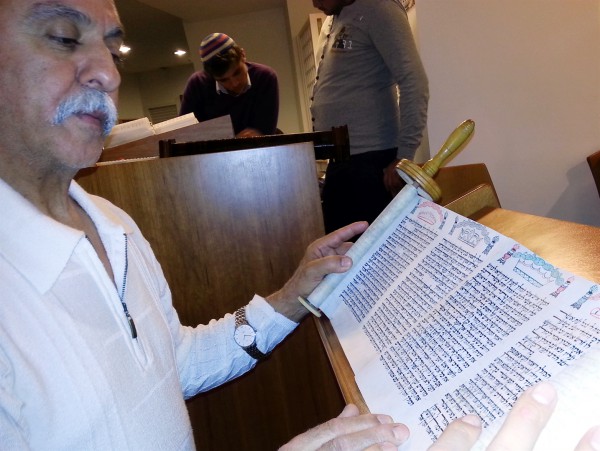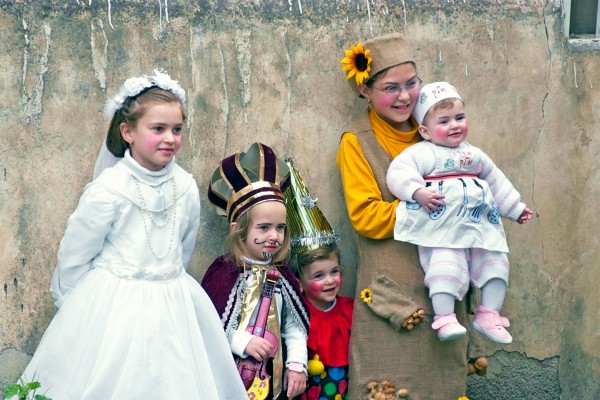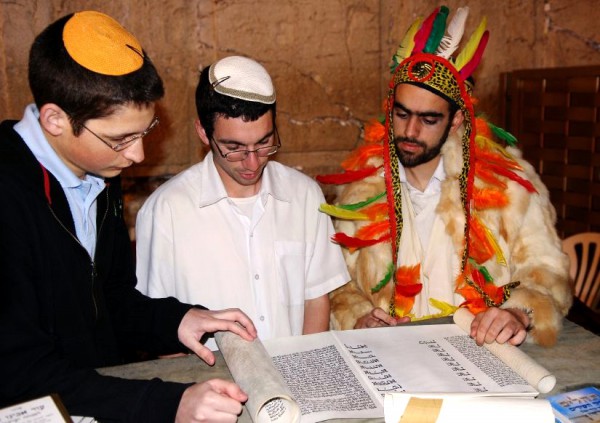“Therefore the Jews … made the fourteenth day of the month Adar a day of gladness and feasting, a good day, and of sending portions one to another.” (Esther 9:19)
One of the happiest days celebrated by Jews all over the world begins tonight—Purim (Feast of Lots)!
This is a celebration of the deliverance of the Jewish People from a Persian plot to annihilate them in about 352 BC.

Carnivals and parades occurs throughout Israel in celebration of Purim. One of Israel’s biggest Purim carnivals and parades is called Adloyada (until one no longer knows) in Holon, a town just south of Tel Aviv.
This year, Purim arrives at a critical junction in time.
Yesterday, Israeli Prime Minister Benjamin Netanyahu stood before the United States Congress seeking American support for a harder line against Iran, a nation threatening to annihilate Israel—a nation descended from the very people who threatened to annihilate the Jewish People almost 2,400 years ago.
Netanyahu gave a multi-count indictment of the Iranian regime, saying, “Iran’s Supreme Leader Ayatollah Khomeini spews the oldest hatred of anti-Semitism with the newest technology. He tweets that Israel must be annihilated. He tweets. You know, in Iran there isn’t exactly free Internet, but he tweets in English that Israel must be destroyed.”
He continued, “For those who believe that Iran’s threatened the Jewish state but not the Jewish people, listen to Hassan Nasrallah, the leader of Hezbollah, Iran’s chief terrorist proxy. He said, ‘If all the Jews gather in Israel, it will save us the trouble of chasing them down around the world.’”
And in case anyone still thinks that a nuclear-armed Iran is only a threat to Israel, Netanyahu spotlighted the international threat.
“But Iran’s regime is not merely a Jewish problem any more than the Nazi regime was merely a Jewish problem. The six million Jews murdered by the Nazis were but a fraction of the 60 million people killed in World War II. So, too, Iran’s regime poses a great threat—not only to Israel, but also to the peace of the entire world,” he said.
Netanyahu stressed that although “the people of Iran are very talented people” and “heirs to one of the world’s great civilizations,” religious zealots “hijacked” Iran in 1979 and imposed a “dark and brutal dictatorship.”
“I’m standing here in Washington, D.C. and the difference is so stark. America’s founding document promises life, liberty and the pursuit of happiness. Iran’s founding document pledges death, tyranny, and the pursuit of jihad. And as states are collapsing across the Middle East, Iran is charging into the void to do just that,” he said.

The known activity of Iran’s Quds Special Forces and Iran’s proxy in Lebanon, the terrorist group Hezbollah.
Just a couple of days earlier at the American Israel Affairs Committee Policy Conference (AIPAC) in Washington on Sunday, Netanyahu said:
“Iran is the foremost state sponsor of terrorism in the world. Look at that map. As you see, it shows Iran training, arming, dispatching terrorists on five continents. Iran envelopes the entire world with its tentacles of terror. This is what Iran is doing now without nuclear weapons. Imagine what Iran would do with nuclear weapons.
“And this same Iran vows to annihilate Israel. If it develops nuclear weapons, it would have the means to achieve that goal.
“We must not let that happen.”
God Delivers His People on Purim
“In those days as King Ahasuerus sat on his royal throne which was at the citadel in Susa [Sushan]…” (Esther 1:2)
Despite the multitude of threats against the Jewish People, here in the Holy Land, every Israeli child has been awaiting Purim with much anticipation.
This is the day when Jewish children dress up in costumes, exchange gift packages called mishloach manot, and fill the synagogues with the sounds of groggers (noise makers).
It is a time of street parades and benevolence to the poor and needy.
The story of Purim and the reasons behind many Purim traditions are found in the Book of Esther, which recounts how the Jews of Susa and all of Persia were saved from a plot to annihilate the Jewish People.
On Purim, the Book of Esther (Megillat Esther) is read in the synagogues. During the reading, it is traditional for the children to grind their groggers at every mention of the villainous Haman who devised the plot to destroy the Jews.
Since the noise of the grogger is designed to blot out the name of Haman, the rabbi must often wait for the clamor to die down before he can continue reading.
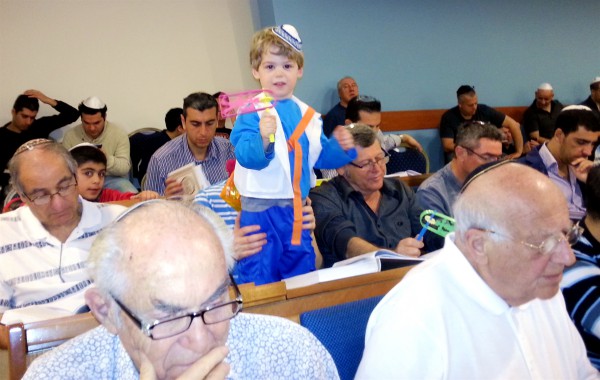
A Jewish boy spins his grogger in the synagogue as he hears Haman’s name during the reading of the Megillat.
Haman was a minister of King Ahasuerus (Xerxes I of Persia), who ruled a vast empire from Shusan in Persia.
It had been decreed that all people should bow down to Haman; however, the Jew Mordecai, would only bow down to the God of Israel. In revenge for Mordecai’s refusal to bow down to him, Haman gained permission from the king to destroy the entire Jewish community:
“Then Haman said to King Xerxes, ‘There is a certain people dispersed among the peoples in all the provinces of your kingdom who keep themselves separate. Their customs are different from those of all other people, and they do not obey the king’s laws; it is not in the king’s best interest to tolerate them. If it pleases the king, let a decree be issued to destroy them, and I will give ten thousand talents of silver to the king’s administrators for the royal treasury.’” (Esther 3:8–9)
Haman drew purim (lots) to determine the best day for carrying out this fateful act, and the lot fell on the 13th of the month of Adar.
When Mordecai learned of the plot, he approached the new queen, his cousin Esther, asking her to intercede before the king on behalf of the Jewish People.
Before approaching the king (an act which could be punished by death) Esther, who had not revealed her Jewish identity, even to the king, asked the entire Jewish community to fast with her for three days.
Esther successfully gained the king’s permission to approach the throne and invited him and Haman to a banquet, at which time she exposed Haman’s plot to kill her and all of her kinsmen. (Esther 7)
Haman was eventually hanged on the same gallows he built for Esther’s uncle Mordecai.
The Jews were then allowed to protect themselves against those who would seek to destroy them.
The 14th and 15th of Adar, therefore, became a time of feasting and joy in celebration of the victory of the Jews over their enemies, leading to the festival of Purim.
Celebrating the Triumph of Good Over Evil
Purim is traditionally celebrated on the 14th of Adar, the day following the victory of the Jews over their adversaries.
In cities that are protected by a surrounding wall, such as Jerusalem, the celebration is moved to the 15th of the month on a day called Shushan Purim. This is because fighting in Susa (Shushan), which was a walled city, continued through the 14th of Adar.
The Book of Esther itself tells us that Purim should be celebrated by feasting and gladness and by sending gifts to one another (usually food), and gifts to the poor.
The following are the ways in which Purim is celebrated:
- Exchanging gifts of food and drink known as mishloach manot
- Giving charity to the poor known as mattanot la-evyonim
- Eating a special meal known as a se’udat Purim
- Public recitation—the reading of the megillah (the Scroll of Esther), known as kriat ha-megillah, in synagogues
- Reciting additions, known as Al HaNissim, to the daily prayers and the grace after meals
Although essentially a celebration of religious freedom, Purim is also a classic story of good versus evil.
It is a time to rejoice over the defeat of Haman’s evil plan to destroy the Jewish People and to celebrate the bravery of Queen Esther when she spoke out publicly on behalf of the community.
But Esther, who could navigate society without anyone suspecting that she was Jewish, did not immediately see the benefit of speaking out.
When she hesitated, her uncle Mordecai reminded her that ultimately she may have been placed in her position so that she could stand against this evil.
He told her: “For if you remain silent at this time, relief and deliverance for the Jews will arise from another place, but you and your father’s family will perish. And who knows but that you have come to your royal position for such a time as this?” (Esther 4:14)
Although Mordecai doesn’t mention God directly, he seems to imply that God has elevated Esther to the position of queen.
In fact, God is not directly mentioned at all in the Book of Esther, seemingly working hidden behind the scene, much like Esther herself, whose Jewish identity remains hidden.
Mordecai also has a hidden identity, as it is not known that he is Esther’s uncle.
This theme of hidden identities is the reason for the wearing of costumes on Purim.
Costumes and Moral Conflict During Purim
Purim isn’t only a time for children and the poor—Israelis of all ages participate in the festivities by dressing up in all kinds of costumes.
Traditionally, these costumes revolve around Biblical characters and reflect Jewish values.
“When I was a child growing up in South Bend, Indiana, there were basically five costumes to choose from; they represented the main characters in the Purim Megilla (the Esther scroll). They were Queen Esther—arguably the most popular among the young girls; Queen Vashti, who was less popular; Mordecai—a biggy among the boys; Haman—not so popular, and finally, King Ahasuerus—also not so popular,” said Barry, a Bibles For Israel team member.
Although the traditional costumes, especially Queen Esther and Mordecai, are still popular within the Haredi or Ultra-Orthodox community, in Israel today it is an altogether different story.
Costumes now range from Darth Vader to celebrity soccer players, with some famous Israeli rabbis sprinkled in among a broad range of superheroes, as well as movie characters, clowns, anthropomorphic animals, etc.
“Among my own grandchildren living in Jerusalem, one grandson dressed up as a can of Sprite, and twin girls were dressed as bees,” Barry said.
Naima Abalya, whose family started the country’s first costume manufacturer in Tel Aviv over 30 years ago, told the Israeli news source Ynet that Israeli air force pilot costumes are very popular following the Gaza war.
However, not all Jewish People support our troops in this way.
The Haredi organization Badatz Eida Haredit is banning the wearing of IDF costumes, claiming that parents have a “duty” to not encourage their children to accept being drafted into the Israeli military (a very hot subject within the ultra-Orthodox religious community that prefers to send their sons to rabbinical yeshivas and avoid the draft).
In past years, even within such Orthodox neighborhoods as Bnei Brak and Mea Shearim, the soldier’s costume has been very popular. But now this rabbinical body has published on Rosh Chodesh Adar [the beginning of the month in which Purim falls] a letter calling on parents to stop from encouraging their children to dress up as Israeli soldiers—as part of “the struggle” against the “draft decree” mandating Haredi enlistment.
The letter states: “We stand today against the terrible decree for recruiting young men in Israel to the melting pot of national service and the military. On the approach of the Purim holiday, wherein the children of Israel tend to dress up like them—and it is known that the greatest leaders of the previous generation forbade it, as the draft decree will force [our children] to assimilate to them and admire the military, etc.” And it further advises, “It is proper to distance and alienate ourselves from them [secular Israeli society] and all they symbolize and express.”
The letter stresses the importance of cultural isolationism. (Arutz 7)
That isolationism is also expressed in the censoring of ads. Here in Israel, once popular costumes such as the Jewish matriarch Rachel and even Queen Esther no longer appear in ads, although the costumes are available for purchase.
This reflects a trend in the ultra-Orthodox community to not publish photos of women or of feminine dress.
Noting the two extremes in the Israeli press—where on the one hand there is a total restriction against photos of girls or woman, and on the other hand, there are photos of women that border on pornography—the Religious-Zionist movement Ne’emanei Torah Va’Avodah complained:
“The despicable treatment of women, on both sides, strengthens extremism and creates a public domain which ranges between over-conservatism and over-permissiveness. The public is responsible for designing a road in the middle, which respects human beings and does not see them as an object.” (YNet)
While this social, religious, and political struggle over women and costumes seems odd, especially in light of the fact that it was a woman who courageously stood in the gap to make a difference for freedom, both religious and secular Jews agree that it is right to celebrate the great miracle recorded in the Book of Esther.
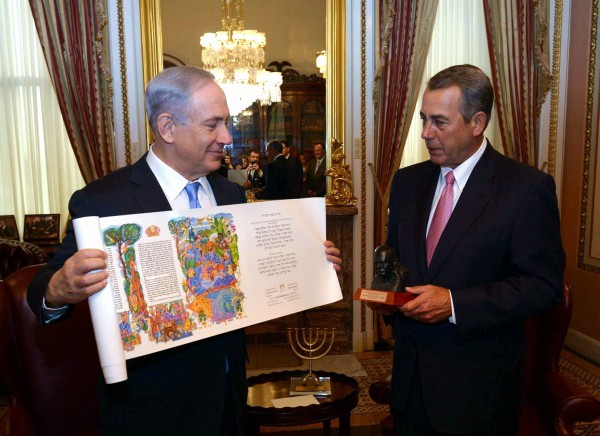
Prime Minister Benjamin Netanyahu presents House Speaker John Boehner with a scroll of the Book of Esther. Boehner presents him with a bust of Winston Churchill because Churchill and Netanyahu are the only foreign leaders who have addressed Congress three separate times. (GPO photo by Amos Ben Gershom)
God Delivers People Through People
Purim reminds all of us that though evil designs to destroy the Jewish People continuously arise, God is faithfully working behind the scene to save His people. He allows us to partner in His plans by placing us in positions of favor in which we can boldly speak and have our voice heard, even though such action may cause us trepidation.
Of course, this reminds us of the first Passover—in which God placed Moses in Egypt to lead the Jewish people out of captivity. To accomplish God’s plan, Moses had to overcome his fear of public speaking.
The Passover Haggadah reminds us, “In each and every generation they rise up against us to destroy us. And the Holy One, blessed be He, rescues us from their hands.”
So as we celebrate Purim—the holiday that celebrates the rescue of the Jews from the hands of Haman and his mob—we do not have to search far to find those who are currently threatening Israel.

“Yesterday, on the eve of my trip to the US, I came here to the Western Wall. As Prime Minister, it is my obligation to see to the security of Israel; therefore, we strongly oppose the agreement being formulated with Iran and the major powers, which could endanger our very existence. In the face of this danger we must unite and also explain the dangers stemming from this agreement, to Israel, to the region and to the world,” PM Netanyahu said.
Today’s Persia, which is Iran, continuously threatens the destruction of Israel and is feverishly working to gain its own atomic weapons while professing to use its nuclear power for peaceful purposes.
As we hear of “talks” and extensions of talks, Israel as a nation must stand steadfast, ready to courageously speak out against Iran’s nuclear program as Prime Minister Netanyahu did in the US this week.
“History has placed us at a fateful crossroads,” Netanyahu told Congress. “We must now choose between two paths. One path leads to a bad deal that will at best curtail Iran’s nuclear ambitions for a while, but it will inexorably lead to a nuclear-armed Iran whose unbridled aggression will inevitably lead to war. The second path, however difficult, could lead to a much better deal that would prevent a nuclear-armed Iran, a nuclearized Middle East and the horrific consequences of both to all of humanity.”

“The days when the Jewish People remain passive in the face of genocidal enemies, those days are over,” Netanyahu told Congress. (Photo: Netanyahu Facebook page)
“My friends, standing up to Iran is not easy. Standing up to dark and murderous regimes never is,” he said. “With us today is Holocaust survivor and Nobel Prize winner Elie Wiesel. Elie, your life and work inspires to give meaning to the words, ‘Never Again.’
“And I wish I could promise you, Elie, that the lessons of history have been learned. I can only urge the leaders of the world not to repeat the mistakes of the past. Not to sacrifice the future for the present; not to ignore aggression in the hopes of gaining an illusory peace.”
Despite the reluctance of the ultra-Orthodox to participate in Israel’s military, and despite growing anti-Semitism and anti-Israelism around the globe, Netanyahu displayed every confidence that Israel will stand its ground against every threat.
“Even if Israel has to stand alone, Israel will stand. But I know that Israel does not stand alone. I know that America stands with Israel. I know that you stand with Israel. You stand with Israel because you know that the story of Israel is not only the story of the Jewish People but of the human spirit that refuses again and again to succumb to history’s horrors,” he continued.

Prime Minister Benjamin Netanyahu meets with Nobel Peace Prize laureate Elie Wiesel. (GPO photo by Amos Ben Gershom)
Purim reminds us that God has placed each of us for such a time as this.
As we all speak forth the truth, we know that we are in God’s hands. He will never leave us nor forsake us, especially while we stand for Israel in these Last Days and are obedient to His will.
Moses eventually overcame his fears, and Netanyahu reminded Congress of the words of Israel’s first leader to his people:
“Be strong and courageous. Do not be afraid or terrified because of them, for the Lord your God goes with you; He will never leave you nor forsake you.” (Deuteronomy 31:6)





